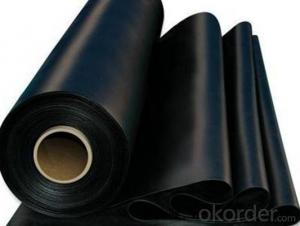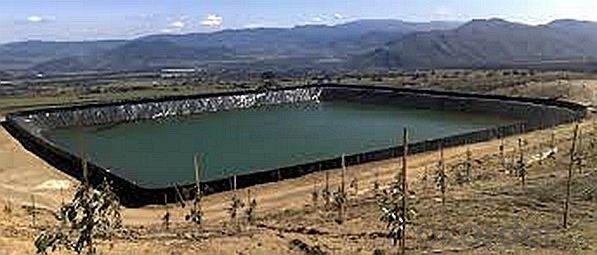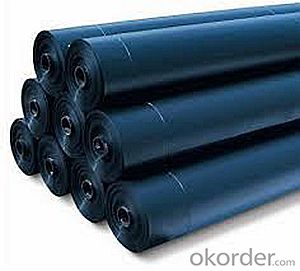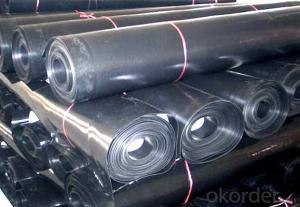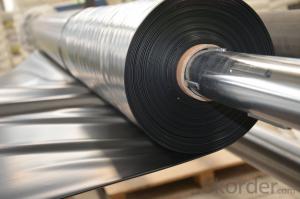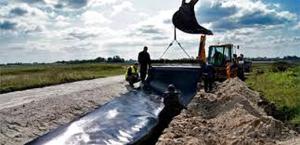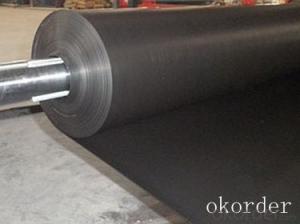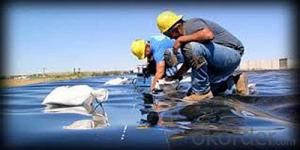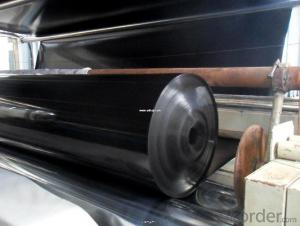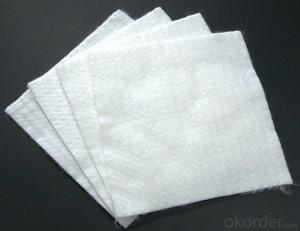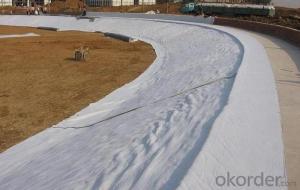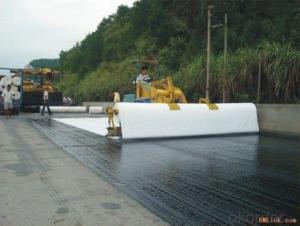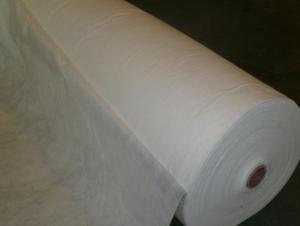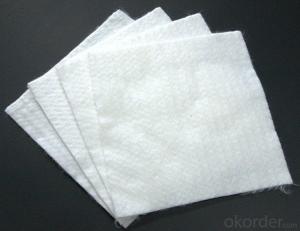Geotextile Reinforced Linear Low-Density Polyethylene Geomembrane for Gravel Driveway and Decorative Architectural Ponds
- Loading Port:
- China main port
- Payment Terms:
- TT OR LC
- Min Order Qty:
- 1000 m²
- Supply Capability:
- 1000000 m²/month
OKorder Service Pledge
OKorder Financial Service
You Might Also Like
Specification
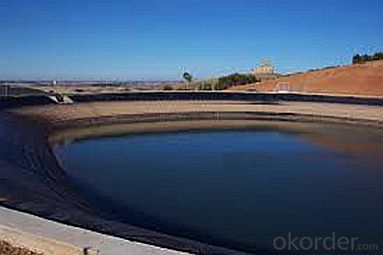
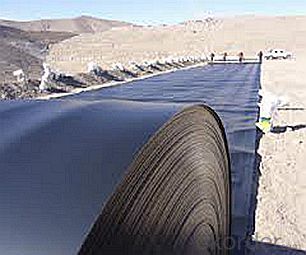
Technical specifications of HDPE geomembrane:
a) Density ≥ 0.94g/m2
b) Tensile Strength ≥25Mpa
c) Elongation at Break ≥ 550%
d) Right-angled Tear ≥ 110N/mm
e.)Puncture Strength ≥ 550N
f.) Permeability Coefficient ≤1.0xe-13g.cm/(cm2.S.Pa)
g.) -70oC Low Temperature Impact Brittle Property: good.
h.) Chemical Resistance: at 80oC, marinated in 5g/L Nacl for a long time, it will not erode or swell.
Specification:
Length:50m or 100m per roll
Width:2-7.5 meter
Thickness:0.2mm,0.25mm,0.5mm,0.75mm,1.0mm,1.25mm,1.5mm,2.0mm.etc
Color:Black or white or blue or as per your request
Our Service
Quality assurance
1.On a regular basis or as per your request,we entrust national testing agencies to conduct quality inspections
2. Strictly in accordance with the ISO9001-2008 international quality system standard,we monitor and manage the whole process throughout production,quality testing,and measurement to ensure product quality
3. For quality-related construction delay or substandard construction(except for damage or losses due to customer’s responsibility or irresistible natural disasters),we have refunding,replacement,and repair services.We will respond to customers’ feedbacks on quality issues within 24 hours.
Q: What kind of payments does jenor support?
A: T/T, L/C, Cash are accepted.
Q: Do you charge for the samples?
A: Accordeing to our company policy, the samples are free, we only charge the freight fee. And we will return the freight fee during the next order.
Q: Can you produce according to customers' design?
A: Sure, we are professional manufacturer, OEM and ODM are both welcome.
Q: Do you have other products?
A: Yes, please check the pictures:
- Q: How do geotextiles contribute to climate change adaptation?
- Geotextiles contribute to climate change adaptation by providing effective solutions for erosion control, slope stabilization, and flood prevention. By reinforcing soil and preventing erosion, geotextiles help to protect vulnerable areas from the impacts of climate change, such as increased rainfall and extreme weather events. They also aid in water management by reducing sediment runoff and improving overall drainage systems. Additionally, geotextiles can be used in the construction of green infrastructure, such as permeable pavements and green roofs, which help mitigate urban heat island effects and improve stormwater management. Overall, geotextiles play a crucial role in enhancing resilience to climate change impacts and promoting sustainable development.
- Q: What are the cost considerations for geotextiles?
- The cost considerations for geotextiles depend on various factors such as the type and quality of geotextile required, the size and complexity of the project, and the supplier or manufacturer chosen. Generally, the cost of geotextiles includes the product cost, transportation and delivery charges, installation expenses, and any additional materials or equipment required. It is important to carefully evaluate and compare prices from different sources to ensure the best value for money while meeting the project's specific needs.
- Q: SNG400-3.5 geotextile is what model
- SNG400-3.5 refers to the national standard polyester staple acupuncture non-woven geotextile 400g / ㎡, width 3.5m. The index code for staple acupuncture nonwoven geotextiles is generally SNG / (1) (2) / (3) - (4) / (5). (1) that the use of raw materials fiber code: PET-polyester, PP-polypropylene, PA-nylon, PV-vinylon, PE-Ethylene (conventional polyester are generally vacant omitted code) (2) that polyester staple fiber non-woven Geotextile per unit area weight. (3) that the composite products in the polyester staple fiber non-woven geotextile weight per unit area, non-composite product vacancies. (4) width, expressed in meters (5) production department number: can express the product more specific characteristics, functions, varieties, sequences, etc., the general vacancy. For example, a 3.5m wide 400g / ㎡ polyester staple fiber nonwoven geotextile representation can be SNG / PET400-3.5, can also be expressed as SNG400-3.5
- Q: What are the maintenance requirements for geotextile-reinforced slopes?
- The maintenance requirements for geotextile-reinforced slopes include regular inspection to check for signs of erosion or damage, ensuring proper drainage to prevent water accumulation, and promptly addressing any issues such as tears or slippage of the geotextile. Additionally, vegetation control may be necessary to prevent root intrusion and maintain slope stability. Regular monitoring and maintenance activities are essential to ensure the long-term effectiveness and performance of geotextile-reinforced slopes.
- Q: How do geotextiles affect soil properties?
- Geotextiles can significantly impact soil properties by improving stability, erosion control, filtration, and drainage. They act as a barrier to prevent soil erosion and retain soil particles, enhancing the stability of slopes and embankments. Geotextiles also enhance filtration by allowing water to pass through while retaining sediments, which improves water quality. Additionally, they enhance drainage by facilitating the flow of water through the soil, preventing waterlogging and maintaining optimal soil moisture levels. Overall, geotextiles play a crucial role in improving soil properties and protecting against erosion and other soil-related issues.
- Q: Can geotextiles be used for reinforcement in retaining walls?
- Yes, geotextiles can be used for reinforcement in retaining walls. They are commonly used to provide stability and prevent soil erosion behind the retaining wall. Geotextiles can help distribute loads and reinforce the soil, enhancing the overall strength and longevity of the retaining wall structure.
- Q: What is the lifespan of geotextiles?
- The lifespan of geotextiles can vary depending on various factors such as the quality of the material, the type of application, and the environmental conditions. However, on average, geotextiles are designed to last anywhere from 15 to 25 years.
- Q: How do geotextiles improve the stability of slopes?
- Geotextiles improve slope stability by providing reinforcement and erosion control. They are placed within the slope to act as a barrier against soil movement, preventing erosion and enhancing the overall stability of the slope. Additionally, geotextiles help to distribute loads more evenly, reducing the potential for slope failure.
- Q: Geotextile vertical permeability coefficient to retain a few digits
- According to GB / T-1998 in the short wire geotextile permeability coefficient, K = 1.0-9.9 between, so this coefficient should be retained after a decimal.
- Q: Waterproof geotextile in which the location of the culvert, what use
- Used in the top and side, lining the inside, mainly the role of waterproof to prevent water seepage. Huazhi geotechnical materials manufacturers need to answer for your needs
Send your message to us
Geotextile Reinforced Linear Low-Density Polyethylene Geomembrane for Gravel Driveway and Decorative Architectural Ponds
- Loading Port:
- China main port
- Payment Terms:
- TT OR LC
- Min Order Qty:
- 1000 m²
- Supply Capability:
- 1000000 m²/month
OKorder Service Pledge
OKorder Financial Service
Similar products
Hot products
Hot Searches
Related keywords
